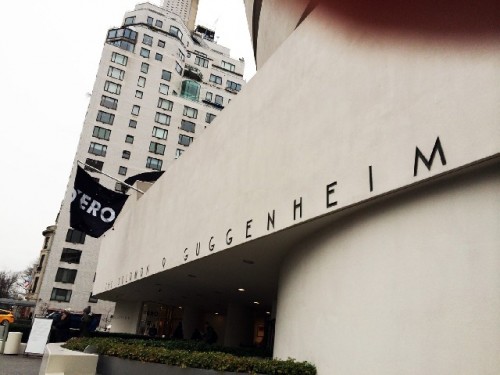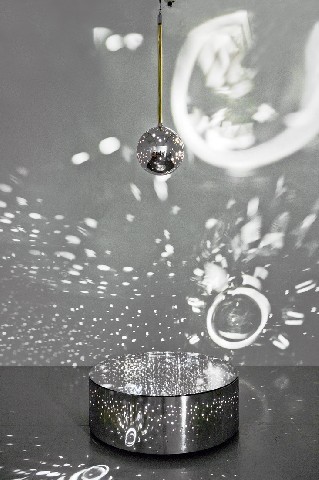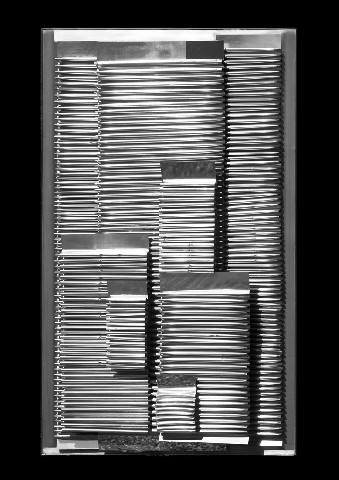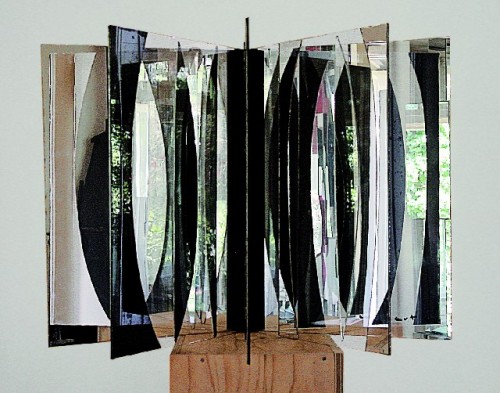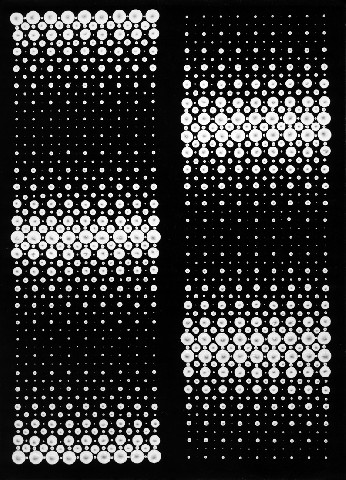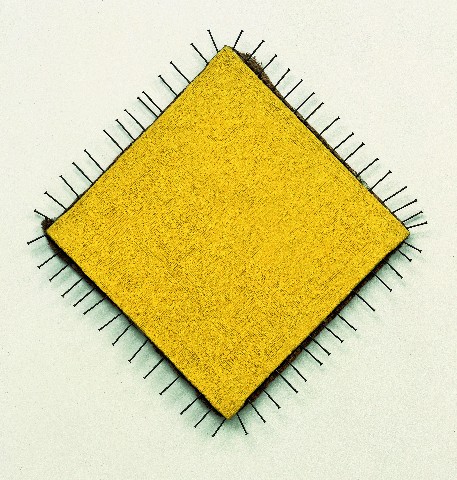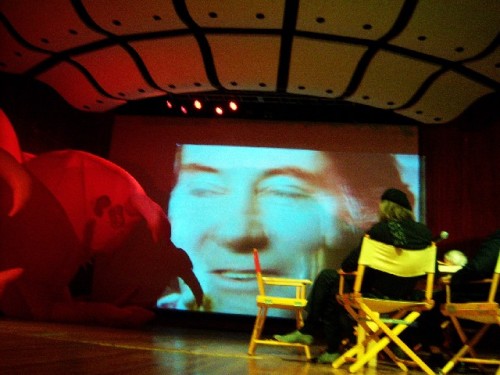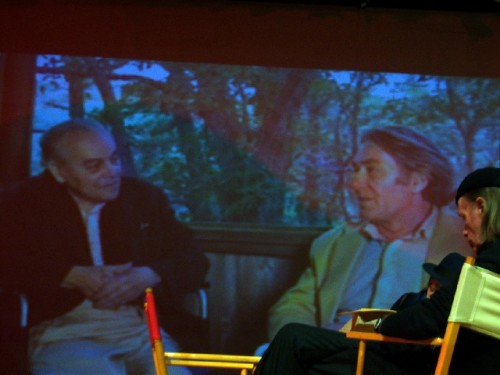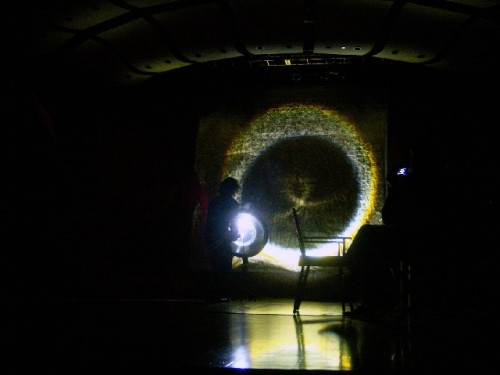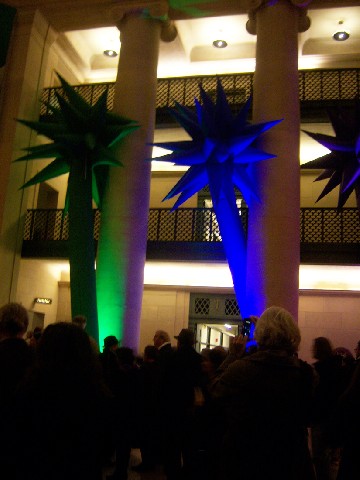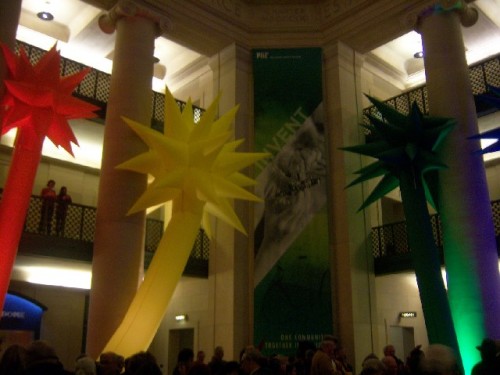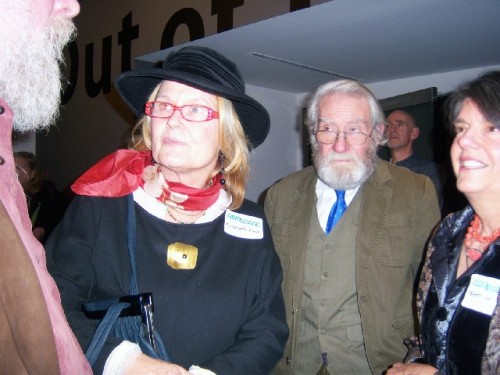ZERO: Countdown to Tomorrow at Guggenheim Museum, NY
Otto Piene an Artist and Mensch
By: Astrid Hiemer - Dec 17, 2014
Solomon R.Guggenheim Museum, New York City
ZERO: Countdown to Tomorrow, 1950s-60s
October 10, 2014 – January 7, 2015
When the exhibition opened in October we had wanted to be in New York and take part in the Guggenheim Memorial for Otto Piene one Friday morning, the day of the Opening. It was not to be. We had prior scheduled travel plans and finally, we visited the exhibition in early December.
It was, as I had expected, an overwhelming experience. We started, as usually, by taking the elevator to the top floor, then we walked the downward spiral, passing and viewing or experiencing fifty or more gallery spaces, which are unique to the Guggenheim architecture. More than 40 artists from 10 countries comprise this exhibition.
Our first stop in the large, elongated gallery, which is still a turn above the fourth floor, had the installation from the 1964 Lichtraum, documenta 3, Hommage a Fontana, Mack, Piene, Uecker, (1964 Light Space) – so titled in protest of Fontana’s exclusion to documenta 3. There they were: Piene’s slowly moving sphere, illuminating the space; Heinz Mack’s mobile, inside a white sculpture, creating visual illusions; moving disks, various lights; then Guenther Uecker’s large round and turning floor piece, which is decked with long nails – and the installation did not work!
Techies were hard pressed to bring 1960s technology up again to 2014 standards. We left disappointed, but then, we had seen most of the works separately over the years. Later, Charles insisted that we return to the gallery, when the enthusiastic guard exclaimed: “He did it! He made it! He got it on!” Members of the tech-department were all there, enjoying lights, shadows and the early technological artworks along with visitors.
In 1958 Piene and Mack showed their first one-night exhibition in, I believe, Piene’s studio in Duesseldorf. For some time they held other one-night exhibitions, happenings and the Zero Magazine documented the group’s and other European art activities. In 1961 Uecker joined Zero, now a trio of founding members. Piene once told me: “Early on we were all hammering nails into wood at night, lucky that we had an understanding land-lord.” They all had day-jobs and families.
Ultimately, Uecker is known for his nail paintings, and other objects/sculptures with protruding nails. The works are mostly painted white. Here, a thought provoking piece, Arrow picture – Das Loch des Herzens translates really into ‘The hole in the heart.’ A relatively small sculpture: Untitled, 1958, presents a welded nail cube, painted white, erected above a white marble base.
Mack, over time, claimed silver as ‘his color.’ One of the works in the exhibition is a 1961 Light Relief, hand-embossed aluminum on wood in four sections. His works project carefully various light effects. An early visit to the Sahara led to The Sahara Project, 1959-61, which was also discussed in the third and final Zero magazine. In 1968 Mack went with a German television crew to Tunesia. The expedition resulted in Tele-Mack, Land Art: A Series of Projects in a Silver Suit.
Artists were ‘burning, cutting, nailing (in the aftermath of WWII) in order to turn destruction into positive art making’ was noted in one of the early exhibition brochures. Piene created fire and smoke or soot paintings and drawings. Here shown: Seventh Attempt to Burn the Night, 1960, and Night Sun (The Moon upon which it depends), 1961. And a smaller Piene space half way down the ramps contained three Light sculptures titled: Metal, 1961, Light Drum, 1969 and Light Ballet (Light Satellite), 1969.
In 1961 ZERO exhibited for the first time at the Galerie Schmela in Duesseldorf. Like minded artists throughout Europe, who were defining painting in new ways, began to show together in various countries. Groups formed: Nouveaux Realistes, Paris/France; Nul artists in the Netherlands, Azimuth in Rome, Italy, in Japan Gutai Group, Jesus Rafael Soto, was born in Venezuela and moved to Paris as a young man. The North American artists George Rickey lived much of his life also in Berlin and exhibited with ZERO.
A number of artists participated in this exhibition with whom we were not familiar and following are a selection of works that stand out in my visual mind:
Louis Fontana, Italy, three rough Spheres Cut Open, 1964, and his famous Concetti Speciale from 1947 to 1968. The exhibition painting is titled, Concetto Speciale, Attese, 1957. The olive green painting with slashes into the canvas is not as familiar as his monochrome red paintings.
Yves Klein, France, 1928-1962, Pure Blue Pigment. He had actually received an international patent for his color, which is generally known as ‘Yves Klein Blue,’ a mesmerizing deep blue-purple. Every time I see one of his paintings, I just take in the color with a deep breath! - I remember Piene saying once that ”Yves did not have to die so early. He knew that he had a heart condition, yet continued to work and push himself too hard.”
Arman, France/Italy, The Little Sweets, 1961, aluminum foil in glass. It’s a rectangular and tall glass sculpture, which is filled with bon-bon foil cups. How sweet indeed!
Armando, Netherlands, Black Barbed Wire on Black 9 - a work I had not seen before. The tall black rectangular painting with six strings of barbed wire demands attention.
Yayoi Kusama, Japan, No.2 J.B., oil, canvas and rice blossoms – a delicate work. Christian Maegert, Germany, Mirror Shard Book, 1962 – of several mirrored book pages and looking into it one’s image refracts into several parts.
Almir Mavignier was born in Rio de Janeiro and moved to Europe in the 1950s, His Convex – Concave II wall work explores negative and positive spaces.
The George Rickey sculpture, Six Horizontal Lines, 1968 represent one of a series of small sculptures atop a square base. The six slowly moving metal criss-crossing lines are carefully fastened to a vertical support and a Rickey Hallmark.
Pol Bury’s Soft Erection, 1961, nylon thread on red wood with electric motor caused a delightful smile. The many threads seem to move without a motor.
Finally, as we were winding down our way to almost the beginning of the exhibition, we arrived at the largest space, which we had already viewed from one floor above: 13 works of art including Piene, Bury, Jean Tingely, Uecker, Mack, Klein, Jesus Rafael Soto and Daniel Spoerri. They ranged from Piene’s 1957 Proliferation of the Moon, an oil and soot painting, to Mack’s 1958 Vibration of Light and Spoerri’s three paper rolls. One of the many word notations on the rolls reads: “Are artists superfluous.” Clearly a provocative question asked in Europe some 10 years after WWII ended. Artists were contributing their visions to a new beginning and reconstruction.
The subtitle of this article refers to Piene alone, with whom I worked at MIT’s Center for Advanced Visual Studies as the CAVS administrator since 1975 for approximately 10 years. Later, he would entice me on occasion to take part in various projects.
Much had been reported in America and Europe, especially in Germany about Piene’s passing on July, 17 shortly after the Opening of his exhibition at the Neue Nationalgalerie in Berlin (New National Gallery). The three part exhibition, Otto Piene: More Sky continued with large scale slide projections, The Proliferation of the Sun, until October. A scheduled Sky Art event, launching three white inflatable ‘Stars’ happened on July 19 in his honor and memory. He was in a happy mood at 86.
Piene’s illustrious career spanned 60 years as a multi media and multi faceted artist and Elder Statesman. He was an exceptional human being, a firm humanist, who worked for peace. He was by no means without flaws. Piene leaves a vast artistic legacy, which will only grow in recognition in future times.
His major works have been cited in biographical sketches, articles and books world-wide. What stands out for me today from the CAVS years are memories of people he drew toward the Center for Advanced Visual Studies, projects and conferences, who touched me personally deeply and has given me and us remaining connections and friendships:
Otto gave me lasting life in the arts and indirectly a now twenty year long relationship with my husband, Charles Giuliano, who had at Center events tried to connect with me. It happened eventually. This is an attempt to draw my picture of the man and Mensch and his surroundings.
It was October 15, 1975, the first day of Arttransition, a CAVS/MIT sponsored five day long conference, when I began my new life in the arts, and it was Piene as director, who had hired me. What an introduction to the arts! Arttransition brought together for the first time at MIT artists, scientists, engineers, students and many others from the US and world-wide. We were attempting to forge new understanding, communications and collaborations in the arts and respective fields - then and for the future. It became a guiding theme for many following endeavors.
The Center for Advanced Visual Studies, a Center for Arts and Technology, opened in 1968 under Gyorgy Kepes. Later the subtitle included Arts, Science and Technology, when Otto Piene became its second director in 1974. He remained at the helm for 20 long years.
While bringing together an initial archive in early 2000 I counted files and documentation for 100 projects and exhibitions that The Center, Piene and/or Research Fellows had sponsored, developed or presented nationally and internationally during the 10 years that I had been the Administrative Officer, a strictly MIT term.
Artists from around the world were appointed by the President of MIT as Research Fellows or Associate Fellows to CAVS for mostly a year at a time. At the height of Center activities there were 45 appointments – plus the MSVisS Master Degree program (Master of Science in Visual Studies) included between 1977 and 1993 up to 10 CAVS students as well. The relatively small, modern, grey corner building with tall sky lights at 40, Massachusetts Avenue, in Cambridge, was bulging with artists, faculty and a small staff, each claiming a work space. Large studios were shared by several and rooms below the main floor were turned into work spaces. A poster for the CAVS retrospective exhibition after 25 years boasts approximately 300 names.
Many were nomad-artists with commitments to exhibitions and projects in the western and southern hemispheres. Mobility, in the best sense of the word, was the accepted norm. That included Piene or Otto, as he was generally known by anyone, who worked with him. No disrespect intended, he was undoubtedly the Center’s strong leader for all those years. He flew at least monthly to Duesseldorf and often to other destinations. He continued to maintain a studio in Duesseldorf; much of his own activities were centered in Germany. From there he also coordinated his and CAVS’ many European activities. He turned offers that could have been his alone into Center projects, where graduate students to senior artists would find a role to participate. I recently read in a memorial poem by Fellow and friend, Juergen Claus that Otto crossed the Atlantic more than 1000 times!
Faculty and Fellows taught generally ten courses per semester in Environmental Art, Art and Technology and its many practices: Kinetic, light, laser, holography, sky and media art, celebrations, public art, etc. - as well as courses covering areas in the sciences. Early collaborators and friends of CAVS were Professors Walter Lewin, a nuclear physicist and Harold ‘Doc’ Edgerton, who became famous for his work and images with stroboscopy, ultra-high-speed photography and sonar. Two of his best known images: Milk Drop Coronet, 1957 and .30 Bullet Piercing an Apple, 1964.
Piene coined the term ‘Sky Art’ and was its most ardent practitioner. His largest and perhaps dearest sky art project happened early on, at the finale of the Munich Olympics, 1972. The Olympic Rainbow was launched high above the Olympic Stadium – a sign for peace that was urgently needed after a horrendous tragedy! Piene enlisted nearly 300 workers and volunteers, who made the rainbow fly high in the sky. It consisted of five colors and 250 m (750ft.) long polyethylene tubing.
Later sky art projects with inflatable sculptures, were titled: Brockton Flower, Blue Star Linz, Milwaukee Anemone, Brussels Flower, Berlin Star. They were named after their first launch places, yet many more sky events occurred over decades. Lees Ruoff and crew sewed additional enormous, intricate inflatable sculptures from rip stop material: Carousel, Icarus and Minautaur for Icarus, a sky opera by Paul Earls. These sky events require a crew of ‘launchers,’ tubing or created forms filled with helium and relatively still weather conditions, which would not always cooperate on first try.
Public Art, intended to please all, allows for participation in various ways. We recall a day-time event at First Night, Boston in the 1980s, where children and families could play with these super balloons at reachable height. The next day, a Boston Globe photo showed Olivia, my daughter, who had participated that year in the First Night Parade as leading a human horse and decked out with a very high white top hat. She made the front page, while Otto’s event-photo was part of the inside spread reporting on First Night. He handed me the newspaper, laughed and said that she had bumped him off the first page. Olivia, Chloe and Jessica were all close in age, growing up, while Otto, Elisabeth and I were ‘wo/manning the shop.’
Piene, his wife and codirector, Elizabeth Goldring Piene, convened four Sky Art Conferences in Cambridge, Munich and Greece between 1981 and 2002, on the subject with its many faceted practitioners. Presentations and papers proposed developments in several areas, the Sky Art Manifesto was another one if its outcomes and all were looking toward the arts in the 21st Century.
Centerbeam comes to mind: A 144 feet long technological sculpture included natural phenomena and invited visitors to interact directly. Centerbeam was designed for the 1977 documenta 6 in Kassel, Germany. Documenta’s director and chief curator, Manfred Schneckenburger, had commissioned it after visiting Otto and the Center. Originally 13 CAVS artists participated, following weeks of heated discussions, design and fabrication, here and in Germany.
Then, Centerbeam was repeated in 1978 in Washington D.C. on the Washington Mall, as a summer long public art piece with events for children and adults alike. 19 artists participated this time and estimate 250,000 visitors came to enjoy it during the day and at night, when Paul Earls and Piene launched evening sky art, steam and laser projections. Centerbeam was built next to the Air and Space Museum on the only empty space around the Washington Mall. I recall sitting next to Otto in the field one morning after the opening in Washington’s unbearable heat and humidity complaining that I felt terribly depressed! “Ah – you have the after project blues…” was his response.
Some of the participating artists were: Lowry Burgess, design and concept; Joan Brigham, steam sculptor; Harriet Casdin-Silver, first solar tracked holograms with Equivocal Forks; Paul Earls, composer of Icarus and laser artist; Elizabeth Goldring, writer and coordinator for the project; Gyorgy Kepes collaborated with Earls on laser images; Christopher Janney, Sound Shuffle/Light Walk; Paul Matisse, water prism and calliroscopic White River; Carl Nesjar, Brine/Ice Line; Alejandro Sina, glass encased Neon/Argon Line and, of course, Piene with Sky sculptures.
Contributing engineers and scientists, without whom the project would not be possible: William Cadogan, project engineer; Solar Tracking: Walter H.G. Lewin, Stephen Benton, Kenneth Kantor, Michael Naimark and more. Many companies had contributed to this technological mirage.
Discussions with Piene to revive a Centerbeam version in Germany were under way in recent years. Will the project come to life again?
Other major exhibitions and projects followed: 5 Artists – 5 Technologies, Grand Rapid, Michigan, 1979; LightsOROT at Yeshiva University Museum in New York City, 1988; Sonderausstellung Otto Piene und das CAVS, Badischer Kunstverein, Karlsruhe, Germany, 1988. (Special Exhibition – Otto Piene and CAVS.) And many more!
I recall a very sick Charlotte Moorman arriving at the Center with her husband Frank Pileggi. The year was probably 1990. She prepared for an evening performance in the three story tall space at CAVS that we called ‘The Pit.’ Charlotte was transformed from sick to glowing artist as she walked down the stairs to a stage-like platform. I can still see her performing a Yoko Ono felt-bag piece. She also stepped into a slightly warm water drum – Charlotte was deathly ill – she lived to perform. Otto and CAVS supported her in life and art in multiple ways.
Moorman performed for decades with Nam June Paik around the world. Still, their most famous piece is titled: TV Bra for Living Sculpture, (as of) 1969.Paik, himself, became a visiting artist on several occasions as have many other visitors contributed to life, works, and lectures during the years.
We cherish owning a maquette of the Kendall Square Fountain, Galaxy in Cambridge, which Otto and Fellows Joe Davis (design, steel work) and Joan Brigham (steam) constructed with assistants in 1989. A steel globe, perhaps our earth, is surrounded by several planets or moons. It would come to live with steam released from area buildings. Today it is unfortunately a silent fountain. The City of Cambridge, perhaps MIT, should maintain the steam and light fountain!
Otto continued to draw me into Center and personal projects, part-time. Last, I worked on translations, during a four year period, of essays written by 43 personalities from all areas of the arts, his work and MIT, as well as several of his own essays, intended for publication in a Catalogue Raisonnee: Otto Piene.
A number of these essays made it into the book. Delight Edition, Paris, under Ante Glibota published an exquisite volume of more than 700 pages with hundreds of black and white and color images throughout, in 2011. The book’s growth and development took nearly twenty years and Glibota dedicated it to Elisabeth in recognition of her unwavering support through all those years.
Official book launchings were scheduled: The mayor of Duesseldorf at City Hall introduced this exquisite document and celebration of a major artist’s life and work and one of its own citizens. In Paris, the publication was introduced in conjunction with a conference on Art and Technology - naturally.
We participated at the 2013 Conference on International Opportunities in the Arts, presented by TransCultural Exchange at Boston University. There, we attended a session on Art and Research’s Dissemination and Impact on Contemporary Art and Its Creators. Gordon Knox, Museum Director, Arizona State University described the careful pairing of artists with scientists and engineers at the university and presented two successful projects.
Then, he gave credit to the Center for Advanced Visual Studies at MIT for being the first university to sponsor and foster such work. My response drew a round of applause and laughter, when I described our method of creating work relationships in 1975 and on: We handed newly arrived Fellows the MIT telephone book, when they had not established work connections in advance. The MIT campus was unlimited and Piene its original engineer.
I attended the MIT memorial celebration for Otto on November 8, which drew former Fellows and others from across the USA, Canada, and Germany. The booklet printed for this sad occasion reads on the first page: 'This celebration was prepared by CAVS Fellows and students who loved Otto.' Indeed! There were so many Fellows attending, so many hugs from people I had not seen in years.
Sarah Geitz contributed this quote:
Otto transcended war by lighting the abyss…
And he taught others to do the same.
Following a series of subject related articles that were written for publication at BFA:
http://www.berkshirefinearts.com/07-19-2014_group-zero-co-founder-otto-piene-at-85.htm
http://www.berkshirefinearts.com/12-16-2012_gunther-uecker-at-haunch-of-venison.htm
http://www.berkshirefinearts.com/05-08-2011_sky-art-2011-at-mit.htm
http://www.berkshirefinearts.com/05-06-2011_honoring-otto-piene-at-grand-palais-paris.htm
http://www.berkshirefinearts.com/03-19-2011_monograph-otto-piene-by-ante-glibota.htm
http://www.berkshirefinearts.com/04-18-2010_otto-piene-at-sperone-westwater.htm
http://berkshirefinearts.com/04-14-2010_new-mit-program-act-inauguration.htm
http://www.berkshirefinearts.com/05-27-2009_yoko-ono-charlotte-moorman-nam-june-paik.htm

